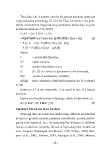Page 673 - 2015-37
P. 673
The utility Uti is random and the ith grower practices improved
crop production technology, if U1i>U2i. Thus, for farmer i, the prob-
ability of practicing improved crop production technology is given
as follows (Kishore et al, 2012):
P (A* > 0) = P (U1i > U2i)
= P{β1Fi(SE1i; G1i;)+ε1i}>{β2Fi(SE2I;G2i;) + ε2i} (2)
= P{( ε1i − ε2i) > Fi(SEti; Gti;) ( β1−β2)}
= P{Vi > Fi(SEti; Gti;) β = φ(Xiβ)
Where
P a probability function,
A* latent variable,
Vi random disturbance term,
β β1−β2 is a vector of parameters to be estimated,
Xiβ vector of explanatory variables,
φ(Xiβ) is the cumulative distribution function for Vi evaluated
at Xiβ.
However, A* is not observable. A is equal to one, if a farmer
practices
Improved crop production technology, which is observable i.e.,
A ={1 if A* > 0, 0 if A* ≤ 0} (3)
Empirical Model and Data Analysis
Although there are numerous studies using different models such
as linear regression models, nonlinear probabilistic models, partici-
patory rural appraisal, etc., for analysing the inluence of different
factors on decision variables, the use of logit and probit models are
more frequent (Pattanayak and Mercer, 1998; Subejo, 2000; Neu-
pane et al., 2002; Johnson, 2005; Adeogun et al., 2008; Muneer,
-8-

